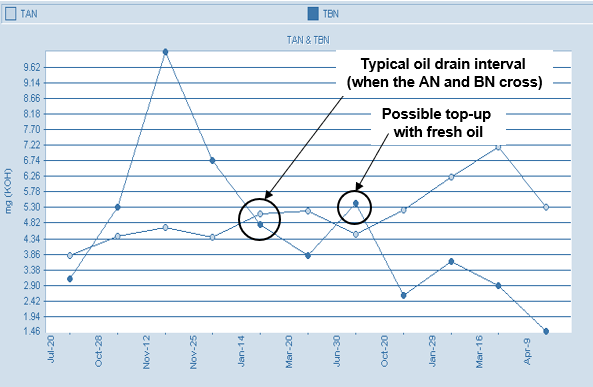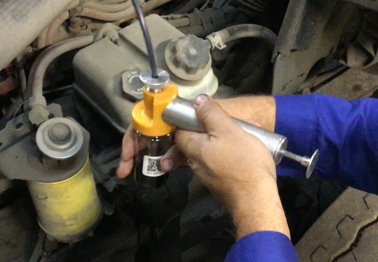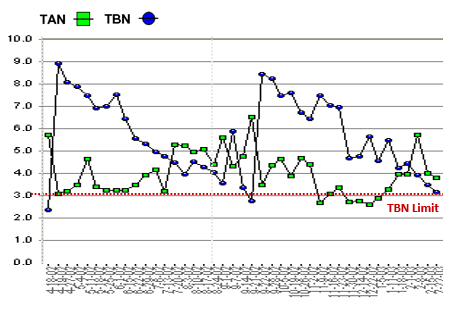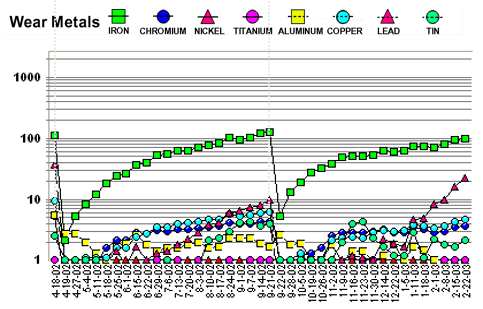The Perils, Pitfalls and Perks of extending oil drain periods
The extension of oil drain periods has long been an area of debate. There are many benefits to be ob...
Base Number is the measure of oil's reserve (remaining) alkalinity. This procedure is used to determine the oil's reserve alkalinity and any depletion changes are always measured from "new" oil levels. Oil change-out should usually be scheduled when the reserve alkalinity has depleted 50%. BN is measured by determining how many "milligrams of Potassium Hydroxide are required to neutralize 1 gram" of oil sample (mg/KOH).
The testing methods, however, are similar and the units, by arbitrary convention, happen to be exactly the same [milligrams of KOH – or potassium hydroxide per milligram of oil]. This convention, despite its seeming arbitrariness, has survived revisions of the test method for decades, so it appears it is here to stay. HCL [hydrochloric acid] is the actual titrant to determine BN.
BN is almost exclusively confined to internal combustion engine oil testing, and addresses the oil’s ability to [continue to] neutralize strong acid [sulfuric acid]) that routinely forms from the combustions process. As such BN never goes up, only down. BN evaluation, therefore, is much like observing a fuel gage until it is time to replenish the fuel tank. When BN is too low [50% depleted or greater], a lube change is usually advisable. BN depletion is somewhat forestalled by the addition of makeup oil, which brings a corresponding measure of alkalinity to the sump, but eventually the BN depletes to change-out levels, unless there is so much oil leakage or consumption that the makeup oil rate is unusually high. Again, there is not necessarily a correlation between BN and AN, but some manufacturers may advise an oil change if the AN is greater than the BN.

Figure - In the graph at right, the BN level has dropped from an initial value of 10 to 1.5. At the same time the AN level has increased from 4.0 to 6.0. This oil is well past due for a change. (oil is a re-refined oil and showed excessive oxidation, nitration and sulfation levels as well. Slight dip in AN level may be due to top-up.)
Seldom do oil analysis laboratories have an opportunity to view such rich oil analysis data. The samples from this case study were obtained by a consultant doing extended oil drain interval testing on a large truck fleet. The samples were all taken following strict sampling procedures and using appropriate sampling hardware. Samples were taken every 50 hours of operation, including a sample of the new oil right after the oil change up to 500 hours of operation on the oil. In addition to this, a full complement of testing was conducted on each sample, including Acid Number (AN) and Base Number (BN).
This case study illustrates the effects of setting both conservative and aggressive BN limits. A conservative BN limits is generally considered to be the point when the BN and AN numbers cross or when the BN reaches about 50% of the new oil value. This occurs twice in this example, at 07-20-2002 and 02-01-2003. It is interesting to note that the first intersection of the AN/BN occurs very close to the 50% point of the BN number (about 4.5 mg/KOH) while the second intersection of the AN/BN occurs at least 100 hours after the 50% point of the BN. The two spikes at 12-02-2002 and 01-11-2003 indicate oil top-ups which, no doubt, are responsible for the delay in the rise of the AN.

Figure - These are samples from a test engine in a transport fleet. The samples contain a wealth of data showing the gradual depletion of TBN value with the concurrent rise in TAN level. As the TBN value falls below the acceptable lower limit the viscosity is seen to rise rapidly.
An aggressive BN limit would be where the BN level drops below 25% of the original value, or in this case about 2.5 mg/KOH. During the two periods of testing on this engine, the BN value never quite hit this limit, yet it can be seen that the AN rises more dramatically once the BN and AN values cross. After this point the viscosity begins a sharp upward trend (indicating rapid oil oxidation) and also the wear metals indicate a sharp rise in lead, copper and tin if the oil is left in the engine. The increased metals are most likely due to corrosion rather than wear as the engine oil becomes highly acidic and little detergency (evidenced by the low BN) is left to combat these acids.
Figure - This graph demonstrates the classic BN vs. AN crossing. Optimal diesel engine oil drains can be determined by measuring both the Base Number and the Acid Number. When the two lines cross on the graph this is the optimal change-out point, which can be seen about 1/4 of the way across the graph from the left. It's at this point where corrosion predominates in the engine as the oil's detergency package has been mostly depleted.
It is worth noting the way in which the various wear metals increase over time during extended oil drain intervals in an engine. Iron follows a very discernable increase over time while the other metals, notably aluminum do not follow such a distinct pattern. What is illustrated by this data is that the wear metals follow more complex patterns than can be described by a formula that simply factors the expected wear level in ppm against working hours on an oil
Figure - Of particular note during this extended drain interval is the increase in the lead level shortly after the BN and AN values cross on the chart above. The is indicative of corrosive processes beginning to dominate in the engine crankcase.